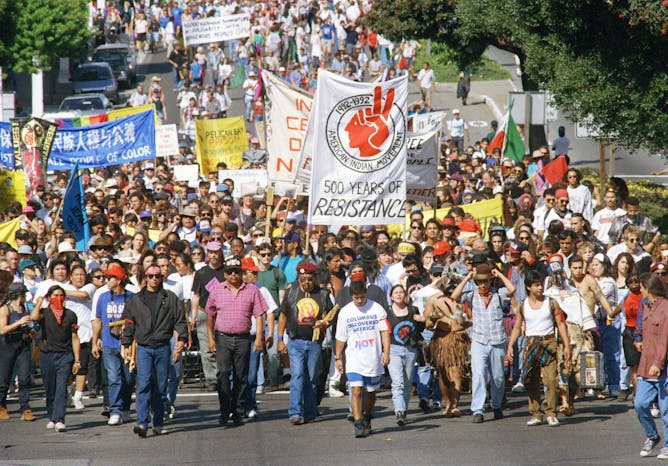Perhaps no holiday has undergone more revisions than Columbus Day. University of North Carolina at Chapel Hill historian Malinda Maynor Lowery tells the story of the holiday’s evolution – first, as a nod to Manifest Destiny; later, as a way to recognize the country’s growing population of Italian American immigrants; and finally, its diminished status, with more and more municipalities celebrating Indigenous Peoples Day as
an alternative to or replacement of the original holiday.
In a way, the changes to the holiday reflect Americans’ evolving understanding of their country and its history, Lowery argues.
Also today:
Top story
|

Marchers celebrate the first Indigenous Peoples Day in Berkeley, Calif. on Oct. 10, 1992.
AP Photo/Paul Sakuma
Malinda Maynor Lowery, University of North Carolina at Chapel Hill
The official celebration of Native Americans represents the fruits of a decades-long effort.
|
Politics + Society
|
-
Michael Traugott, University of Michigan
Members of Congress factor what the public thinks into their decisions. But it's difficult to measure what the public is really thinking.
-
Haidar Khezri, University of Central Florida
Kurdish women have fought on the front lines of military battles since the 19th century. A scholar explains the origins of Kurdistan's relative gender equality in a mostly conservative Muslim region.
|
|
|
|
Indigenous Peoples Day
|
-
Chip Colwell, University of Colorado Denver
An anthropologist who's researched the dispossession of Native Americans and their enduring connections to ancestral places sees the value in asking 'whose land are you on?'
-
Christina Leza, Colorado College
The U.S-Mexico border runs through Native American territories. A wall would further divide these communities, separating children from schools, farmers from water and families from each other.
-
Ashley Minner, University of Maryland, Baltimore County
A folklorist is working to preserve the history of a unique, urban community of Lumbee Indians.
-
Rosalyn R. LaPier, The University of Montana
Many Native languages are dying, and their loss has deep and profound implications for our world.
|
|
Most read on site
|
-
Phillip Yuhas, The Ohio State University
Blue light has been getting blamed for sleep interruption and eye strain. But the facts are that any bright light interferes with sleep, and computers themselves cause eye strain, an eye doctor says.
-
Libby Richards, Purdue University
A common myth cited as a reason for not getting the flu shot is that the shot will give you the flu. That is scientifically impossible. Here's why.
-
Vera Keller, University of Oregon
People have always known science would advance faster with various incentives and rewards. As modern experimental science took off, these took the form of gifts and favors to and from wealthy elites.
|
|
|
|
| |
 |
| Ask them to sign up at https://theconversation.com/us/newsletter |
|
|
| |
|
|